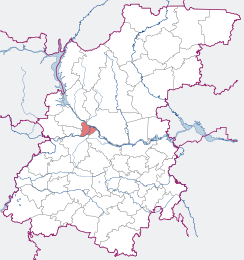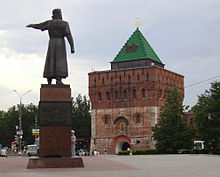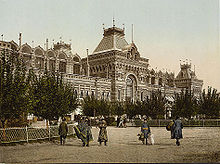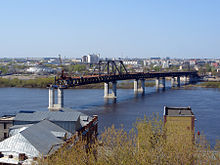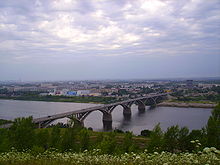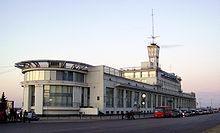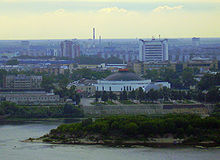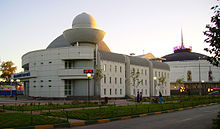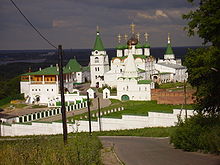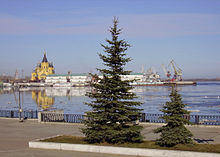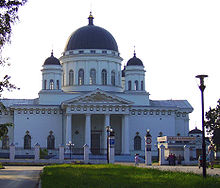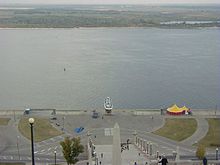- Nizhny Novgorod
-
For other cities named Novgorod, see Novgorod (disambiguation).
Nizhny Novgorod (English)
Нижний Новгород (Russian)- City[1] -
City of oblast significance[1]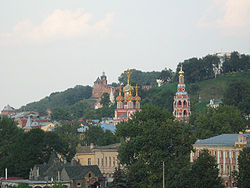
View of Nizhny Novgorod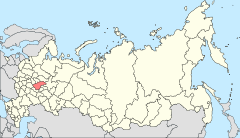
Location of Nizhny Novgorod Oblast in RussiaCoordinates: 56°20′N 44°00′E / 56.333°N 44°ECoordinates: 56°20′N 44°00′E / 56.333°N 44°E Coat of arms of Nizhny Novgorod Flag of Nizhny Novgorod City Day Second Sunday of September[2] Administrative status (as of July 2009) Country Russia Federal subject Nizhny Novgorod Oblast[1] Administrative center of Nizhny Novgorod Oblast[1] Municipal status (as of September 2009) Urban okrug Nizhny Novgorod Urban Okrug[3] Head[5] Oleg Sorokin[4] Representative body City Duma[6] Statistics Area 410.68 km2 (158.56 sq mi)[7] Population (2010 Census,
preliminary)1,250,615 inhabitants[8] - Rank in 2010 5th Population (2002 Census) 1,311,252 inhabitants[9] - Rank in 2002 4th Density 3,045 /km2 (7,890 /sq mi)[10] Time zone MSD (UTC+04:00)[11] Founded 1221[12] City status since 1221[7] Previous names Nizhny Novgorod (until September 1932),[12]
Gorky (until October 22, 1990)[13]Postal code(s) in the 603000–603998 range[14] Dialing code(s) +7 831[7] Official website Nizhny Novgorod (Russian: Нижний Новгород, IPA: [ˈnʲiʐnʲɪj ˈnovɡərət]), colloquially shortened to Nizhny, is, with the population of 1,250,615, the fifth largest city in Russia, ranking after Moscow, St. Petersburg, Novosibirsk, and Yekaterinburg.[8] It is the economic and cultural center of the vast Volga-Vyatka economic region, and also the administrative center of Nizhny Novgorod Oblast and Volga Federal District.
From 1932 to 1990, the city was known as Gorky (Горький, IPA: [ˈɡorʲkʲɪj]),[13] after the writer Maxim Gorky who was born there.
The city is an important economic, transport and cultural center of the Russian Federation.
Contents
History
Seat of medieval princes
After the destruction of the Mordvin Inäzor Obram, a hillfort named Obran Osh (Ashli) at the site of future stone Kremlin in 1220, a small Russian wooden hillfort was founded by Grand Duke Yuri II of Russia in 1221. Located at the confluence of two most important rivers of his principality, the Volga (Mordvin "Rav" or "Rava"), and the Oka, and Obran Osh was renamed Nizhny Novgorod. Its name literally means Lower Newtown, to distinguish it from the older Veliky Novgorod. Its independent existence was threatened by the continuous Mordvin attacks against it. The major attempt made by Inäzor Purgaz from Arzamas in January 1229 was repulsed, but after the death of Yuri II on March 4, 1238 at the Battle of Sit River the Mongols occupied the fortress and the remnants of small Nizhny Novgorod settlement which surrendered without any resistance in order to preserve what had been developed since Purgaz's attack eight years earlier. Later a major stronghold for border protection, Nizhny Novgorod fortress took advantage of a natural moat formed by the two rivers.
Along with Moscow and Tver, Nizhny Novgorod was among several newly-founded towns that escaped Mongol devastation on account of their insignificance, but grew into (great) centers in vassalic Russian political life during the period of the Tatar Yoke. With the agreement of the Mongol Khan, Nizhny Novgorod was incorporated into the Vladimir - Suzdal Principality in 1264. After 86 years its importance further increased when the seat of the powerful Suzdal Principality was moved here from Gorodets in 1350. Grand Duke Dmitry Konstantinovich (1323–1383) sought to make his capital a rival worthy of Moscow; he built a stone citadel and several churches and was a patron of historians. The earliest extant manuscript of the Russian Primary Chronicle, the Laurentian Codex, was written for him by the local monk Laurentius in 1377.
Strongest fortress of Muscovy
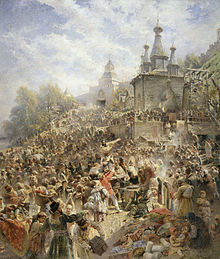 Kuzma Minin appeals to the people of Nizhny Novgorod to raise a volunteer army against the Poles.
Kuzma Minin appeals to the people of Nizhny Novgorod to raise a volunteer army against the Poles.
After the city's incorporation into Muscovy (1392), the local princes took the name Shuisky and settled in Moscow, where they were prominent at the court and briefly ascended the throne in the person of Vasili IV. After being burnt by the powerful Crimean Tatar chief Edigu in 1408, Nizhny Novgorod was restored and regarded by the Muscovites primarily as a great stronghold in their wars against the Tatars of Kazan. The enormous red-brick kremlin, one of the strongest and earliest preserved citadels in Russia, was built in 1508–1511 under the supervision of Peter the Italian. The fortress was strong enough to withstand Tatar sieges in 1520 and 1536.
In 1612, the so-called national militia, gathered by a local merchant, Kuzma Minin, and commanded by Knyaz Dmitry Pozharsky expelled the Polish troops from Moscow, thus putting an end to the "Time of Troubles" and establishing the rule of the Romanov dynasty. The main square before the kremlin is named after Minin and Pozharsky, although it is locally known simply as "Minin Square." Minin's remains are buried in the citadel. (In commemoration of these events, on October 21, 2005, an exact copy of the Red Square statue of Minin and Pozharsky was placed in front of St John the Baptist Church, which is believed to be the place from where the call to the people had been proclaimed.)
In the course of the following century, the city prospered commercially and was chosen by the Stroganovs (the wealthiest merchant family of Russia) as a base for their operations. A particular style of architecture and icon painting, known as the Stroganov style, developed there at the turn of the 19th[citation needed] and 20th[citation needed] centuries.
The historical coat of arms of Nizhny Novgorod in 1981 was a red deer with black horns and hooves on a white field. The modern coat of arms circa 1992 is the same, but the shield can be adorned with golden oak leaves tied with a ribbon with colours of the Russian national flag.
Great trade centre
 Shukhov towers built in Nizhny Novgorod suburbs near Dzerzhinsk in 1927–1929; one of them is still in place
Shukhov towers built in Nizhny Novgorod suburbs near Dzerzhinsk in 1927–1929; one of them is still in place
In 1817, the Makaryev Fair, one of the liveliest in the world, was transferred to Nizhny Novgorod, which thereupon started to attract millions of visitors annually. By the mid-19th century, the city on the Volga was firmly established as the trade capital of the Russian Empire. The world's first radio receiver of engineer Alexander Popov and the world's first hyperboloid tower and lattice shells-coverings of engineer Vladimir Shukhov were demonstrated at the All-Russia industrial and art exhibition in Nizhny Novgorod in 1896. According to official Imperial Russian statistics the population of Nizhny Novgorod as of 14 January 1913 was 97,000.
The largest industrial enterprise was the Sormovo Iron Works which was connected by the company's own railway to Moscow station in the upper part of Nizhny Novgorod. The private Moscow — Kazan Railway Company's station served the lower part of the town. Other industries gradually developed, and by the dawn of the 20th century it was a first-rank industrial hub as well. Henry Ford helped build a large truck and tractor plant (GAZ) in the late 1920s, sending along engineers and mechanics, including future labour leader Walter Reuther.
Soviet era
There were no permanent bridges over the Volga or Oka before the October Revolution in 1917. Temporary bridges were built during the trade fair. The first bridge over the Volga was started by the Moscow-Kazan Railway Company in 1914, but only finished in the Soviet Era when the railway to Kotelnich was opened for service in 1927.
Maxim Gorky was born in Nizhny Novgorod in 1868 as Alexei Maximovich Peshkov. In his novels he described the dismal life of the city proletariat.
Even during his lifetime, the city was renamed Gorky following his return to the Soviet Union in 1932 on the invitation of Joseph Stalin. The city bore Gorky's name until 1991. His childhood home is preserved as a museum, known as the Kashirin House (Russian: Домик Каширина), after Alexei's grandfather who owned the place.
During much of the Soviet era, the city was closed to foreigners to safeguard the security of Soviet military research and production facilities, even though it was a popular stopping point for Soviet tourists traveling up and down the Volga in tourist boats. Unusually for a Soviet city of that size, even street maps were not available for sale until the mid-1970s.
Mátyás Rákosi, communist leader of Hungary, died there in 1971. The physicist and Nobel laureate Andrei Sakharov was exiled there during 1980-1986 to limit his contacts with foreigners.
An end to the "closed" status of the city accompanied the reinstatement of the city's original name in 1990.[13]
Economy
Information technology
Nizhny Novgorod is one of the centers of the IT Industry in Russia. It ranks among the leading Russian cities in terms of the quantity of software R&D providers. In Nizhny Novgorod there are number of offshore outsourcing software developers, including Tecom, Luximax Systems Ltd., MERA Networks, RealEast Networks, Auriga, SoftDrom, and Teleca, that specialize in delivering services to telecommunication vendors. Also Intel has opened a software R&D center with more than 500 engineers in the city.
There are 25 scientific R&D institutions focusing on telecommunications, radio technology, theoretical and applied physics, and 33 higher educational institutions, among them are Nizhny Novgorod State Medical Academy, Nizhny Novgorod State University, Nizhny Novgorod Technical University, as well as Nizhny Novgorod Institute of Information Technologies (former MERA Networks training center), that focuses on information technologies, software development, system administration, telecommunications, cellular networks, Internet technologies, and IT management.
Nizhny Novgorod has also been chosen as one of four sites for building an IT-oriented technology park—a special zone that has an established infrastructure and enjoys a favorable tax and customs policy.
Engineering industry
The engineering industry is the leading industry of Nizhny Novgorod economy. It is mainly oriented towards transportation, i.e., the auto industry, shipbuilding, diesel engines, aircraft manufacture, and machine tools, with the auto industry being the leading sector (50%). Largest plants are:
- JSC "Gorky Automobile Plant" - personal cars, trucks, armored personnel carriers, and other autos;
- JSC "Krasnoye Sormovo" - river and sea ships, submarines;
- JSC "Sokol" - airplanes, jets;
- JSC "Hydromash"- hydraulic actuators, landing gears
- JSC "Nitel" - TV sets;
- JSC "RUMO" - diesel generators;
- JSC "Krasnyy yakor" - anchor chains;
Transportation
One of the three bridges spanning the Oka
Railway transport
Russian Railways department - Gorkovskaya Railroad (Горьковская железная дорога), which operates some 5,700 km of rail lines throughout the Middle Volga region (of which some 1,200 are in Nizhny Novgorod Oblast), is headquartered in Nizhny Novgorod. Overnight trains provide access to Nizhny Novgorod from Moscow, Saint Petersburg, Kazan, Yaroslavl and others. Since December 2002, a fast train transports passengers between Nizhny Novgorod and Moscow in less than five hours. One can continue from Nizhny Novgorod eastward along the Trans-Siberian Railway, with direct trains to major cities in the Urals and Siberia, as well as to Beijing, Pyongyang and Ulan-Bator.
The first high-speed rail Sapsan train to Moscow (Kursky Rail Terminal) and Saint Petersburg (Moskovsky Rail Terminal) was launched on July 30, 2010.[15]
Suburban commuter trains (elektrichka) connect Nizhny Novgorod with Vladimir, Dzerzhinsk, Murom, Kirov, Arzamas, Zavolzhye, Balakhna and others.
Airport
Nizhny Novgorod Strigino Airport has direct flights to major Russian cities, as well as to Frankfurt (five flights a week by Lufthansa). The air base Sormovo was an important military airlift facility, and Pravdinsk air base was an interceptor aircraft base during the Cold War. S7 Airlines, UTair Aviation goes to Moscow Domodedovo airport and Vnukovo airport daily.
Waterways
Nizhny Novgorod is an important center of Volga cargo and passenger shipping. In the summer, cruise vessels operate between Nizhny Novgorod, Moscow, Saint Petersburg, and Astrakhan. In 2006 a small number of Meteor-class hydrofoils resumed operations on the Volga river.
Highway
The city is served by Russian highway M-7 (Moscow – Nizhny Novgorod – Kazan – Ufa), and is a hub of the regional highway network.
Public transport
Public transport within the city is provided by a small subway system (Nizhny Novgorod Metro), tramways, marshrutkas or minibuses, buses and trolleybuses. Electric and diesel commuter trains run to suburbs in several directions.
Free shuttle buses run from several points in the city to the MEGA shopping complex, which opened in October 2006 in Fedyakovo, a few kilometers to the east of the Nizhny Novgorod city line.[16]
City layout
Nizhny Novgorod is divided by the Oka River into two distinct parts. The Upper City (Russian: Нагорная часть, Nagornaya Chast) is located on the hilly eastern (right) bank of the Oka. It includes three of the eight city districts into which the city is administratively divided:
- Nizhegorodsky (the historical and administrative center of the city);
- Prioksky;
- Sovetsky.
The Lower City (Russian: Заречная часть, Zarechnaya Chast) occupies the low (western) side of the Oka, and includes five city districts:
- Kanavinsky (the site of the Nizhny Novgorod Fair and the location of the main train station);
- Moskovsky (home of the Sokol Aircraft Plant and its airfield);
- Sormovsky (where Krasnoye Sormovo and the Volga Shipyard are located);
- Avtozavodsky (built around the GAZ automotive plants);
- Leninsky.
All of today's lower city was annexed to Nizhny Novgorod in 1929–1931.
The city has many industrial suburbs, such as Kstovo, Dzerzhinsk, and Bor. The town of Semyonov, to the north of Nizhny Novgorod, is known as a craft center for Khokhloma wood painting. Another suburb, Balakhna, is noted for its medieval architecture.
Main sights
Much of the city downtown is built in the Russian Revival and Stalin Empire styles. The dominating feature of the city skyline is the grand Kremlin (1500–1511), with its red-brick towers. After Bolshevik devastation, the only ancient edifice left within the kremlin walls is the tent-like Archangel Cathedral (1624–31), first built in stone in the 13th century.
Cultural features
There are more than six hundred unique historic, architectural, and cultural monuments in the city.
There are about two hundred municipal and regional art and cultural institutions within Nizhny Novgorod. Among these institutions there are eight theaters, five concert halls, ninety-seven libraries (with branches), seventeen movie theaters (including five movie theaters for children), twenty-five institutions of children optional education, eight museums (sixteen including branches), and seven parks.
Nizhny Novgorod art gallery
The art gallery in Nizhny Novgorod is a large and important art gallery and museums of human history and culture.
Nizhny Novgorod has a great and extraordinary art gallery with more than 12,000 exhibits, an enormous collection of works by Russian artists such as Viktor Vasnetsov, Karl Briullov, Ivan Shishkin, Ivan Kramskoi, Ilya Yefimovich Repin, Isaak Iljitsch Lewitan, Vasily Surikov, Ivan Aivazovsky, there are also greater collections of works by Boris Kustodiev and Nicholas Roerich, not only Russian art is part of the exhibition it include also a vast accumulation of Western European art like works by David Teniers the Younger, Bernardo Bellotto, Lucas Cranach the Elder, Pieter de Grebber, Giuseppe Maria Crespi, Giovanni Battista Piranesi, and lot more.
Finally what makes this gallery extremely important is the amazing collection Russian avant-garde with works by Kazimir Malevich, Wassily Kandinsky, Natalia Goncharova, Mikhail Larionov and so on. There is also collection of East Asian art.
Houses of worship
Other notable landmarks are the two great medieval abbeys. The Pechersky Ascension Monastery features the austere five-domed cathedral (1632) and two rare churches surmounted by tent roofs, dating from the 1640s. The Annunciation monastery, likewise surrounded by strong walls, has another five-domed cathedral (1649) and the Assumption church (1678). The only private house preserved from that epoch formerly belonged to the merchant Pushnikov.
There can be little doubt that the most original and delightful churches in the city were built by the Stroganovs in the nascent Baroque style. Of these, the Virgin's Nativity Church (1719) graces one of the central streets, whereas the Church of Our Lady of Smolensk (1694–97) survives in the former village of Gordeevka (now, part of the city's Kanavinsky District), where the Stroganov palace once stood.
Other notable churches include:
- the Saviour Cathedral, also known as the Old Fair Cathedral, a huge domed edifice built at the site of the great fair to an Empire style design by Agustín de Betancourt and Auguste de Montferrand in 1822;
- the so-called New Fair Cathedral, designed in the Russian Revival style and constructed between 1856 and 1880 at the confluence of the Oka and the Volga;
- the recently reconstructed Church of the Nativity of John the Precursor (1676–83), standing just below the Kremlin walls; it was used during the Soviet period as an apartment house;
- the parish churches of the Holy Wives (1649) and of Saint Elijah (1656);
- the Assumption Church on St Elijah's Hill (1672), with five green-tiled domes arranged unorthodoxly on the lofty cross-shaped barrel roof;
- the shrine of the Old Believers at the Bugrovskoe cemetery, erected in the 1910s to a critically acclaimed design by Vladimir Pokrovsky;
- the wooden chapel of the Intercession (1660), transported to Nizhny Novgorod from a rural area.
There is also a mosque in Sennaya Square, where the Muslim populations of the city go for Friday prayers, Islamic activities and activities which are organized by the mosque. There is also a small shop to buy halal meats. Most of the Muslims in this city are Tatars.
The centrally located Nizhny Novgorod Synagogue was built in 1881-1883; disused during the Soviet era, it was renovated and reopened ca. 1991.
Other
A singular monument of industrial architecture is a 128-meter-high open-work hyperboloid tower built on the bank of the Oka near Dzerzhinsk as part of a powerline river crossing by the eminent engineer and scientist Vladimir Shukhov in 1929.
A staircase connecting the Kremlin with the Volga river offers a panoramic view of the surroundings. The staircase itself was constructed in the late 1940s by German prisoners of war forced to labor around Gorky.
Education
Nizhny Novgorod is home to the following educational facilities:
- N. I. Lobachevsky State University of Nizhny Novgorod
- R.Y. Alekseev Nizhny Novgorod State Technical University[17]
- Nizhny Novgorod State University of Architecture and Civil Engineering
- Nizhny Novgorod State Linguistic University
- Nizhny Novgorod Commercial Institute
- Nizhny Novgorod State Pedagogical University
- Nizhny Novgorod State Medical Academy
- Nizhny Novgorod State Agricultural Academy
- Volgo-Vyatsky Region Civil Service Academy[18]
There are also twenty research institutes located in the city.
Sports
The city ice hockey team Torpedo Nizhny Novgorod play in the KHL. The city is represented at football by FC Volga Nizhny Novgorod which plays in the Russian Premier League. FC Nizhny Novgorod which plays in the Russian First Division. The other football team from Nizhny Novgorod, FC Lokomotiv Nizhny Novgorod which had played in the Russian Premier League and Intertoto Cup became defunct in 2006. The city field hockey team are HC Start. The city bandy team Start plays in the highest division of the Russian Bandy League.[19] In 2002 they reached the final against Vodnik. Both matches were played in Arkhangelsk due to warm weather. After that an artificial ice was built.
World Cup
Russia became the host for the 2018 FIFA World Cup, and it has been decided that some matches will be played in Nizhny Novgorod in a stadium yet to be built. The stadium will be built on an island in the Volga river and will have a capacity of 44 899 people.[20]
Notable people
Main article: List of people in Nizhny NovgorodDemographics
- Population (Jan 2009): 1,272,599 [21]
- Births (2008): 12,969
- Deaths (2008): 20,757
International relations
Twin towns/sister cities
Nizhny Novgorod is twinned with:
 Novi Sad, Serbia
Novi Sad, Serbia Philadelphia, United States
Philadelphia, United States Sant Boi, Spain
Sant Boi, Spain Suwon, South Korea
Suwon, South Korea Tampere, Finland
Tampere, Finland
Climate
The climate in the region is continental, specifically humid continental (Dfb) and it is similar to the climate in Moscow, although colder in winter, which lasts from late November until late March with a permanent snow cover. Averages temperatures ranges from +19 in July to -10 in January.
Climate data for Nizhny Novgorod (1971 - 2000) Month Jan Feb Mar Apr May Jun Jul Aug Sep Oct Nov Dec Year Record high °C (°F) 5.5
(41.9)7.0
(44.6)17.3
(63.1)26.3
(79.3)32.5
(90.5)36.3
(97.3)38.3
(100.9)38.0
(100.4)31.0
(87.8)24.2
(75.6)13.2
(55.8)8.5
(47.3)38.3
(100.9)Average high °C (°F) −6.6
(20.1)−5.7
(21.7)0.7
(33.3)10.5
(50.9)17.4
(63.3)22.5
(72.5)23.4
(74.1)21.2
(70.2)14.8
(58.6)6.9
(44.4)−1.1
(30.0)−4.6
(23.7)8.3 Average low °C (°F) −13
(8.6)−12.2
(10.0)−6.3
(20.7)2.3
(36.1)7.6
(45.7)12.5
(54.5)14.1
(57.4)11.9
(53.4)6.8
(44.2)1.2
(34.2)−5.8
(21.6)−10.3
(13.5)0.7 Record low °C (°F) −41.2
(−42.2)−37.2
(−35.0)−28.3
(−18.9)−19.7
(−3.5)−6.9
(19.6)−1.8
(28.8)5.1
(41.2)0.9
(33.6)−5.4
(22.3)−16
(3.2)−29.4
(−20.9)−41.4
(−42.5)−41.4
(−42.5)Precipitation mm (inches) 40
(1.57)33
(1.3)28
(1.1)36
(1.42)52
(2.05)64
(2.52)76
(2.99)67
(2.64)57
(2.24)59
(2.32)56
(2.2)50
(1.97)618
(24.33)Source: Pogoda.ru.net[23] References
Bibliography
- Munro-Butler-Johnstone, Henry Alexander, A trip up the Volga to the fair of Nijni-Novgorod, Oxford: J. Parker and co., 1876.
- Fitzpatrick, Anne Lincoln, The Great Russian Fair: Nizhnii Novgorod, 1840-90, Houndmills, Basingstoke, Hampshire: Macmillan, in association with St. Antony’s College, Oxford, 1990. ISBN 0-333-42437-9
Sources
- Городская Дума города Нижнего Новгорода. №91 23 ноября 2005 г. «Устав города Нижнего Новгорода», в ред. №54 от 27 мая 2009 г. Вступил в силу с 1 января 2006 г., но не ранее официального опубликования после государственной регистрации, за исключением подпункта 13 пункта 10 статьи 43, вступающего в силу в сроки, установленные федеральным законом, определяющим порядок организации и деятельности муниципальной милиции. Опубликован: "Нижегородский рабочий", №234/15894, 30 декабря 2005 г. (City Duma of the City of Nizhny Novgorod. #91 November 23, 2005 Charter of the City of Nizhny Novgorod, as amended by the #54 of May 27, 2009. Effective as of January 1, 2006, but not earlier than the official publication date following the state registration, and with the exception of subitem 13 of item 10 of Article 43, which takes effect during the timeframe to be set by a federal law legislating the organization and functioning of the municipal militsiya).
- Государственно-правовой департамент Нижегородской области. Приказ №1-од от 25 января 2010 г. «Об утверждении реестра административно-территориальных образований, городских и сельских населённых пунктов Нижегородской области», в ред. Приказа №3-од от 9 апреля 2010 г «О внесении изменений в реестр административно-территориальных образований, городских и сельских населённых пунктов Нижегородской области». Опубликован: "Нижегородская правда", №№26(25202), 27(25203), 29(25205), 30(25206), 32(25208), 33(25209), 35(25211), 13 марта – 3 апреля 2010 г. (State Legal Department of Nizhny Novgorod Oblast. Order #1-od of January 25, 2010 On the Adoption of the Registry of the Administrative-Territorial Formations, Urban and Rural Localities of Nizhny Novgorod Oblast, as amended by the Order #3-od of April 9, 2010 On Amending the Registry of the Administrative-Territorial Formations, Urban and Rural Localities of Nizhny Novgorod Oblast. ).
- Правительство Нижегородской области. Постановление №670 от 11 сентября 2009 г. «О перечне муниципальных образований Нижегородской области». Опубликован: "Нижегородские новости", №177(4309), 1 октября 2009 г. (Government of Nizhny Novgorod Oblast. Resolution #670 of September 11, 2009 On the Registry of the Municipal Formations of Nizhny Novgorod Oblast. ).
- Президиум Верховного Совета РСФСР. Указ от 22 октября 1990 г. «О переименовании города Горького в город Нижний Новгород и Горьковской области в Нижегородскую области». (Presidium of the Supreme Soviet of the RSFSR. Decree of October 22, 1990 On Changing the Name of the City of Gorky to the City of Nizhny Novgorod and the Name of Gorky Oblast to Nizhny Novgorod Oblast. ).
Notes
- ^ a b c d Order #1-od, Article 3.2
- ^ Charter of Nizhny Novgorod, Article 2.2
- ^ Resolution #670, Urban Okrugs, Item 1
- ^ Official website of Nizhny Novgorod. Vadim Yevgenyevich Bulavinov, Head of the Administration of Nizhny Novgorod (Russian)
- ^ Charter of Nizhny Novgorod, Article 26.1.2
- ^ Charter of Nizhny Novgorod, Article 26.1.1
- ^ a b c Official website of Nizhny Novgorod. Overview of the city (Russian)
- ^ a b Федеральная служба государственной статистики (Federal State Statistics Service) (2011). "Предварительные итоги Всероссийской переписи населения 2010 года (Preliminary results of the 2010 All-Russian Population Census)" (in Russian). Всероссийская перепись населения 2010 года (All-Russia Population Census of 2010). Federal State Statistics Service. http://www.perepis-2010.ru/results_of_the_census/results-inform.php. Retrieved 2011-04-25.
- ^ Федеральная служба государственной статистики (Federal State Statistics Service) (2004-05-21). "Численность населения России, субъектов Российской Федерации в составе федеральных округов, районов, городских поселений, сельских населённых пунктов – районных центров и сельских населённых пунктов с населением 3 тысячи и более человек (Population of Russia, its federal districts, federal subjects, districts, urban localities, rural localities—administrative centers, and rural localities with population of over 3,000)" (in Russian). Всероссийская перепись населения 2002 года (All-Russia Population Census of 2002). Federal State Statistics Service. http://www.perepis2002.ru/ct/doc/1_TOM_01_04.xls. Retrieved 2010-03-23.
- ^ The value of density was calculated automatically by dividing the 2010 Census population by the area specified in the infobox. Please note that this value may not be accurate as the area specified in the infobox does not necessarily correspond to the area of the entity proper or is reported for the same year as the population.
- ^ Правительство Российской Федерации. Постановление №725 от 31 августа 2011 г. «О составе территорий, образующих каждую часовую зону, и порядке исчисления времени в часовых зонах, а также о признании утратившими силу отдельных Постановлений Правительства Российской Федерации». Вступил в силу по истечении 7 дней после дня официального опубликования. Опубликован: "Российская Газета", №197, 6 сентября 2011 г. (Government of the Russian Federation. Resolution #725 of August 31, 2011 On the Composition of the Territories Included into Each Time Zone and on the Procedures of Timekeeping in the Time Zones, as Well as on Abrogation of Several Resolutions of the Government of the Russian Federation. Effective as of after 7 days following the day of the official publication).
- ^ a b Charter of Nizhny Novgorod, Article 1.2
- ^ a b c Decree of October 22, 1990, Article 1
- ^ Russian Post. Postal Code Search (Russian)
- ^ "Russian Railways Sapsan to Nizhny Novgorod press release". http://press.rzd.ru/isvp/public/press?STRUCTURE_ID=654&layer_id=4069&refererVpId=1&refererPageId=704&refererLayerId=4065&id=74920.
- ^ How to get to MEGA
- ^ http://www.nntu.sci-nnov.ru/nstu.html
- ^ http://www.vvags.ru/
- ^ Video from a game in the Russian Cup against Zorky from Krasnogorsk: http://www.youtube.com/watch?v=EhwJxkrosd4
- ^ http://www.russia2018-2022.com/en/the-bid/host-cities/nizhny-novgorod.aspx
- ^ "НТА-Приволжье :: В Н.Новгороде в 2008 году уровень смертности превысил рождаемость в 1,6 раза – Нижегородстат" (in (Russian)). Nta-nn.ru. http://www.nta-nn.ru/news/item/?ID=148716. Retrieved 2010-06-01.
- ^ "List of Twin Towns in the Ruhr District". © 2009 Twins2010.com. http://www.twins2010.com/fileadmin/user_upload/pic/Dokumente/List_of_Twin_Towns_01.pdf?PHPSESSID=2edd34819db21e450d3bb625549ce4fd. Retrieved 2009-10-28.
- ^ "Pogoda.ru.net" (in Russian). http://pogoda.ru.net/climate/27459.htm. Retrieved September 8, 2007.
External links
- Nizhny Novgorod City Government website (English)
- Nizhny Novgorod City Guide Travel and business guide to Nizhny Novgorod (English)
- Nizhny Novgorod Welcoming Center website (English)
- Sights of the city (English)
- About the city (English)
- www.hist.nnov.ru/architect/ (Russian)
- Official website of Nizhny Novgorod State Art Museum (Russian)
- Art Museum of Nizhny Novgorod (English)
- http://www.nne.ru The Nizhny Novgorod and Arzamas Archdiocese (Russian)
- Asociacion de amigos de Gorki - (in Spanish) - "Association of friends of Gorki", a UNESCO recognised organisation, was the first tourist group in the city after cancellation of closed status.
- VisitNizhny.com Information about tourism and entertainment in Nizhny Novgorod (English)
- Nizhny Novgorod Video Created by José Antonio Lozano Rodriguez.
- Nizhny Novgorod Video 2 Created by José Antonio Lozano Rodriguez.
- Hovercraft "Hivus" in Nizhny Novgorod (Russian)
- Nizhny Novgorod Bus and Transport Service (Russian)
- Nizhny Novgorod Online (Russian)
- Heather DeHaan. "Nizhnii Novgorod: History in the Landscape" (English)
- Photographic community in Nizhny Novgorod "Photo Gorky" (Russian)
- Entertainment portal in Nizhny Novgorod (Russian)
- Reviews, articles, town legends "The Nizhny Novgorod Cronicles" (Russian)
- Jewish Community of Nizhny Novgorod" (English)
- Archangel's Cathedral, Cathedral of St. Michael the Archangel (Nizhny Novgorod)" (English)
Web-cameras
- 100+ webcams on the Nizhny Novgorod (Russian)
- Web-camera, Gorkogo sq. (Russian)
- Web-camera, Lyadova sq. You could see Okskiy s'ezd, Gagarina prospect, Timiryazeva str. (Russian)
- Web-camera, Gorkogo sq. You could see Novaya str., B.Pokrovskaya str. (Russian)
- Web-camera, Kovalihinskaya and Proviantskaya streets crossing (Russian)
Cities and towns in Nizhny Novgorod Oblast Administrative center: Nizhny Novgorod
 Categories:
Categories:- Cities and towns in Nizhny Novgorod Oblast
- Nizhny Novgorod
- Populated places on the Volga
- 1221 establishments
- Former national capitals
Wikimedia Foundation. 2010.

